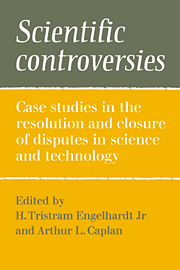 Scientific Controversies
Scientific Controversies Published online by Cambridge University Press: 03 February 2010
The costs imposed by federal regulatory activities serve as banner and litmus test for those seeking to curtail government involvement in the economy. Interest in deregulation encompasses both economic and environmental/public health regulation, although the purposes of each are quite different, as are the criteria appropriate to their assessment. The focus on costs has stimulated an effort to demonstrate the magnitude of benefits provided through regulation. This effort encounters serious methodological difficulties in the environmental/ public health area, including the imputation of economic value to human life, and poorly defined health outcomes.
The Occupational Safety and Health Administration (OSHA) has resisted pressures to quantify the benefits expected from more stringent standards for occupational exposures, but recent and imminent Supreme Court decisions or congressional action may compel the agency to incorporate procedures for weighing benefits and costs to justify exposure standards.
This essay is an examination of some of the pros and cons of this possible development in OSHA's regulatory process. In particular, it argues that benefit–cost methodology is insufficiently developed for handling major elements of regulatory decisions in this area; that its use can only extend the range of controversy, and that the focus of the benefit–cost/efficiency paradigm ignores important aspects of social structure, discouraging efforts to enhance the health resource base of particular groups and neglecting the consequences of the form in which certain costs are imposed.
The past decade has been marked by legislation aimed at controlling human exposure to toxic substances. This legislation includes numerous acts that address various substances in diverse exposure settings.
To save this book to your Kindle, first ensure [email protected] is added to your Approved Personal Document E-mail List under your Personal Document Settings on the Manage Your Content and Devices page of your Amazon account. Then enter the ‘name’ part of your Kindle email address below. Find out more about saving to your Kindle.
Note you can select to save to either the @free.kindle.com or @kindle.com variations. ‘@free.kindle.com’ emails are free but can only be saved to your device when it is connected to wi-fi. ‘@kindle.com’ emails can be delivered even when you are not connected to wi-fi, but note that service fees apply.
Find out more about the Kindle Personal Document Service.
To save content items to your account, please confirm that you agree to abide by our usage policies. If this is the first time you use this feature, you will be asked to authorise Cambridge Core to connect with your account. Find out more about saving content to Dropbox.
To save content items to your account, please confirm that you agree to abide by our usage policies. If this is the first time you use this feature, you will be asked to authorise Cambridge Core to connect with your account. Find out more about saving content to Google Drive.